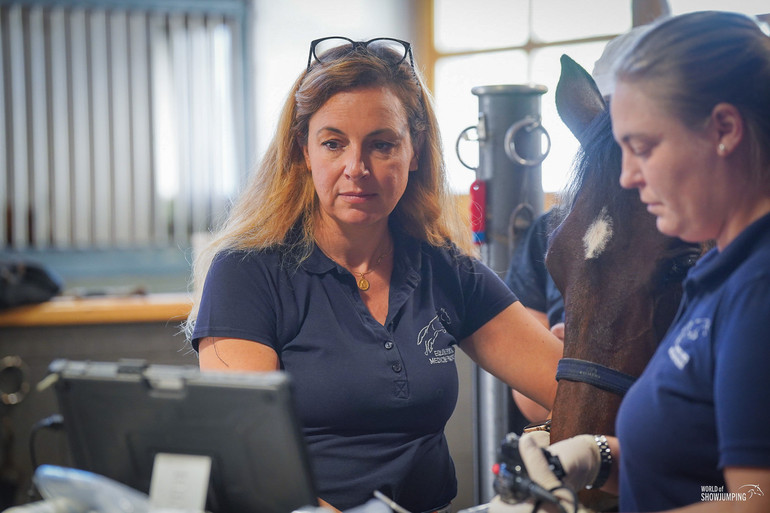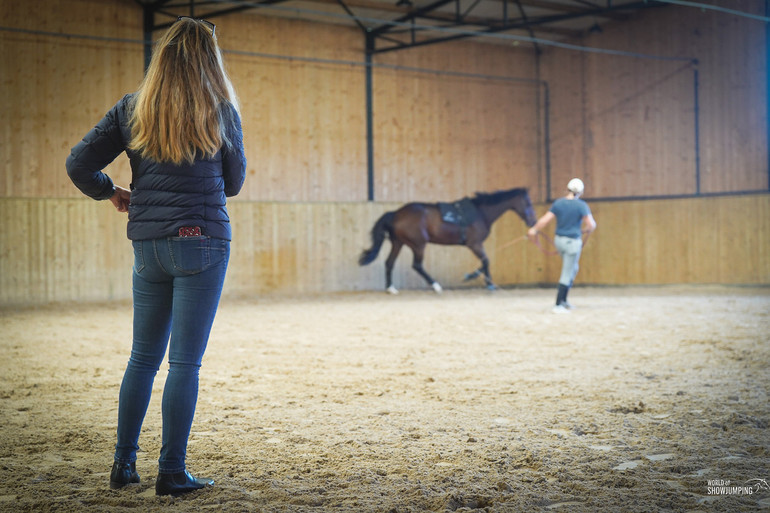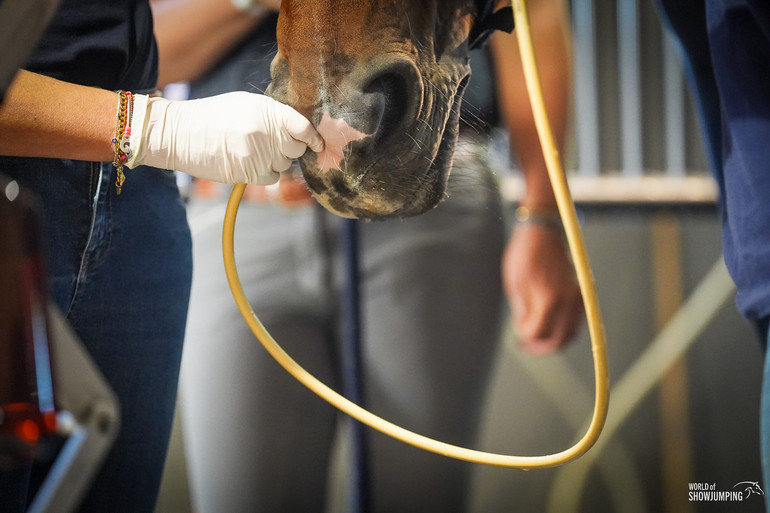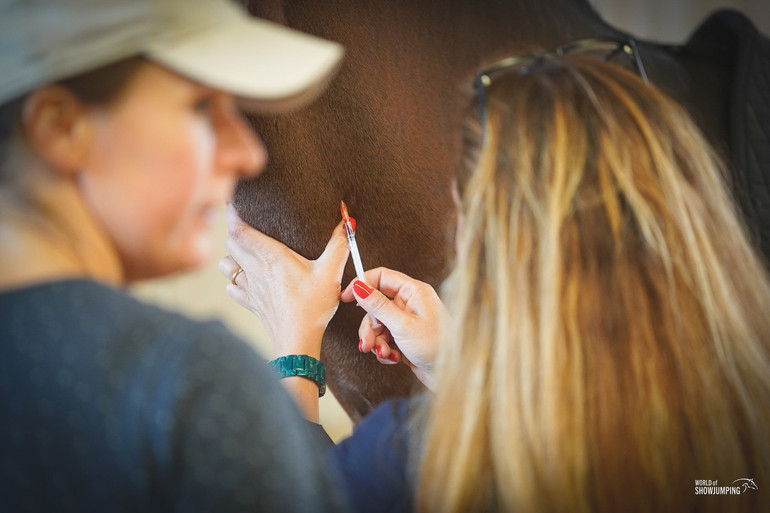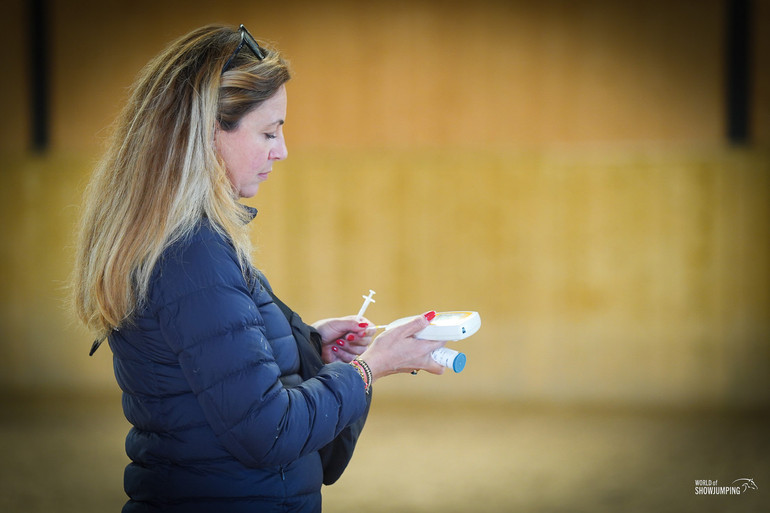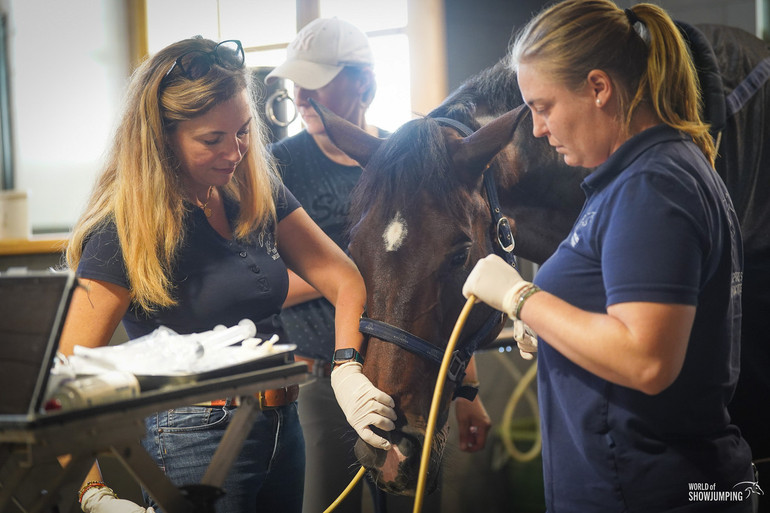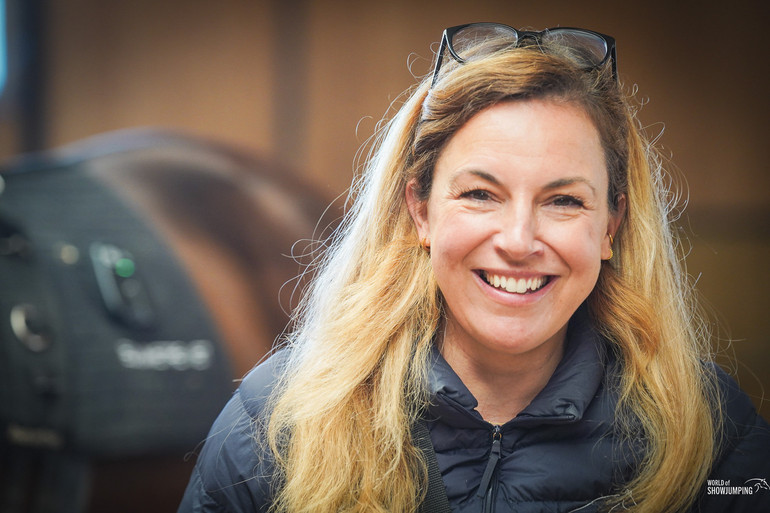Text © World of Showjumping
“The biggest limiting factor for horses, even when they are fit and healthy, is their respiratory systems,” Emmanuelle Van Erck Westergren – founder of the Equine Sports Medicine Practice and president of the Belgian Equine Practitioner Society (BEPS) – tells World of Showjumping. “In comparison, we are much better at detecting lameness issues, because it is visible; you can see when a horse is lame – but a horse with a lower airway issue might only have minor symptoms.”
“The first indicator of respiratory issues is fatigue, and when a horse is tired, it is more prone to having an accident – and those can be minor accidents like stumbling – or not using its muscles as it should. Therefore, musculoskeletal injuries can sometimes actually be a consequence of a horse that initially wasn’t fit in its respiratory system,” Van Erck Westergren points out.
Most common issue in sport horses
According to Van Erck Westergren, the most common issues in sport horses are in fact respiratory problems. “In a study that we did some years ago on horses that were referred to us because of poor performance, about 80% of them had a lower airway disease,” she tells. “This can be explained by several factors: First of all, horses often live in dusty conditions, sleeping on dusty bedding, eating hay that is dusty. In addition, the ventilation in barns is often not optimal and horses are also regularly transported… all these factors can induce lower airway disease.”
A horse that has a lower airway disease is more likely to have issues with fatigue
“One of the biggest factors of them all, however, is the fact that a horse can have a lower airway disease without the rider even noticing, because contrary to general belief, respiratory issues are not always associated with coughing or nasal discharge,” Van Erck Westergren explains. “Your horse can have a lower airway disease and the only sign you see is a horse that is a tiny bit more tired at the end of a training session than usual. A horse that has a lower airway disease is more likely to have issues with fatigue. This is a typical sign, because the oxygen deficit creates fatigue of the muscles as the primary problem.”
“Heart conditions are much less frequent, but when a horse has a heart condition, it can have more significant effects on the performance and that is why we probably have become stricter about symptoms like heart murmurs,” Van Erck Westergren continues. “Murmurs can be a sign of an underlying heart condition, and it is important to make sure that a possible condition is compatible with the goals a horse has in sport. However, the problem is that horses can have heart murmurs without any underlying disease as well. Blood moves through large vessels in the heart, that have certain elastic components – they vibrate – and those sounds can be picked up as a murmur.”
It is important to make sure that a possible condition is compatible with the goals a horse has in sport
“Checking that a horse has no heart murmurs is something that should be done every single time before a vet sedates a horse,” Van Erck Westergren continues. “When you inject a sedative in a horse, it is going to slow down the heart rate and horses can even skip a heartbeat when they are sedated. Therefore, it is very important to check that you don’t have a murmur, because a murmur, or even a very slow heartrate, could indicate that a regular dose of sedative might be too much for that individual.”
Adapted to dealing with extreme oxygen deficit
“Overall, horses are much more athletic than we are and they respond to training fairly easily in comparison us,” Van Erck Westergren begins. “For instance, if we look at the level of the muscle, it takes a horse one month to gain strength where it would take four months for a human to achieve the same type of improvements. When it comes to the heart, horses have a large heart in comparison to their size; if we were the same size as horses, our hearts would be 50% smaller than theirs – proportionally. So, both figuratively and literally speaking, horses do have huge hearts. While the cardiac system is the biggest limiting factor for us humans, it is less often a problem for the horses. When it comes to the respiratory system, horses have several limitations: They have to breathe through the nose, and the fact that they cannot breathe through the mouth makes it more difficult for them to breathe – and their airways are narrow in comparison to their size.”
When it comes to the respiratory system, horses have several limitations
“The rate at which a horse breathes during exercise does not allow the air to stay at the level of the lungs as long as it should to completely download the oxygen to the bloodstream,” Van Erck Westergren continues. “All this combined with the fact that the muscles are very greedy in oxygen, a horse’s respiratory system simply cannot deliver enough oxygen to maintain standard levels during exercise. Progressively, as a horse continues to work – even if it is not at maximum level – it will become hypoxemic, meaning that it will have a deficit in oxygen. However, horses have adapted to that, and they can support levels of hypoxemia that are much more dramatic than those a human could ever sustain. For instance, if you take a race horse at the end of a race – even if it is a super fit elite athlete – the level of oxygen deficit it has, is similar to that of a human who has reached the basecamp of Mount Everest. For a human, it takes several days to adapt to that level of hypoxemia, whereas a horse goes back to normal oxygen levels within minutes. We have to realize that if you add a problem to this – if a horse has a respiratory issue – it is going to enhance the oxygen deficit even more.”
You cannot train the respiratory system
“We have looked at ways horses adapt their different systems to training; their muscles, heart and the lungs, and the best response is from the muscle, the second best is from the heart and the lungs come last – they have a poor response to training,” Van Erck Westergren says when asked how the limits of a horse’s respiratory system should be considered when it comes to training.
The lungs come last – they have a poor response to training
“Training horses on longer distances during longer durations at a lower level of intensity is going to increase the capacity of the muscles to process oxygen and the heart to distribute it, and this way we are improving those other systems – which in turn preserves the airways a little bit,” Van Erck Westergren continues. “What happens when a horse exercises with a deficit in oxygen is that as a consequence, it is going to accumulate lactic acid – a by-product of the energy production in the muscles – and as the name indicates, lactic acids acidify the muscle, leading to fatigue. Every once in a while when you are training your horse, it is a good idea to go at a higher intensity so that the horse gets used to accumulating lactates and, as a result, becomes more efficient in recycling those lactates – and is going to fatigue less. Small breaks during exercise allows the horse to recycle any lactic acid that it would have produced and to balance its oxygen levels. It depends a little bit on what you are trying to achieve, but if you are trying to improve the endurance of the horse, taking those little breaks in between exercise is what you want to do.”
The connection between the lungs and the heart
“The objective of the lungs is to deliver oxygen to the bloodstream, and the heart becomes the pump that is going to distribute oxygen to all the organs and especially to the muscles during exercise,” Van Erck Westergren explains about the close connection between the heart and the lungs.
Physiologically, there is a dynamic between the lungs and the heart
“The cardiac output of blood to muscles during rest is 50%, whereas during exercise it completely shifts and there is a priority that is given to the muscles; 80% of the cardiac output goes to the muscles during intense exercise. The heart pumps the blood that is charged with carbon dioxide – another by-product of energy production – allowing the lungs to evacuate the carbon dioxide and reupload with oxygen,” Van Erck Westergren explains.
“Physiologically, there is a dynamic between the lungs and the heart. As an example, if a horse has a problem in its lungs, instead of having a levelled and efficient distribution of oxygen to the bloodstream, there is an imbalance in the areas that are ventilated, which can create tension in other areas of the lungs and promote several issues. Therefore, it is very important to have healthy lungs. It is also important to understand that the blood pressure in horses’ lungs is about three times higher than that in a human, which makes horses more prone to having exercise induced pulmonary haemorrhage – meaning they are more prone to bleeding from the lungs,” Van Erck Westergren points out.
Take all the preventative measures that you can
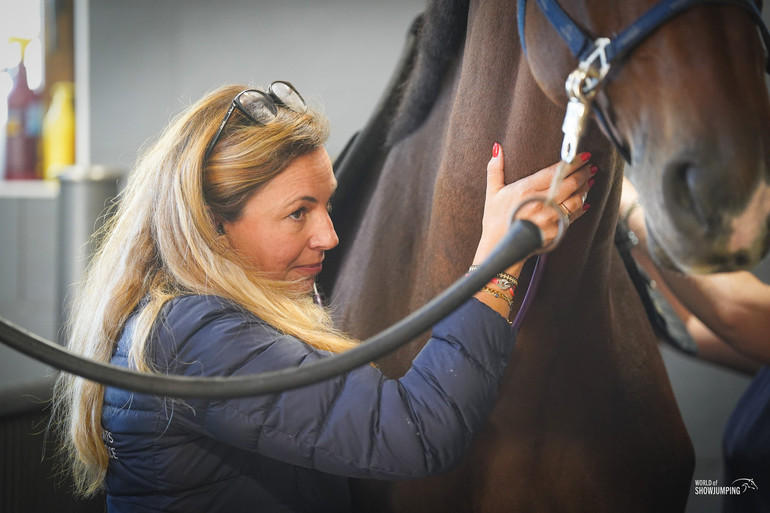 "Riders often think about the diet as the first cause for tiredness, because they believe the horse is not appropriately fuelled with energy. However, the muscles get energy through the diet, but even more importantly, from oxygen – and if you don’t have a good combination of the two, your horse won’t have energy,” Van Erck Westergren points out.
"Riders often think about the diet as the first cause for tiredness, because they believe the horse is not appropriately fuelled with energy. However, the muscles get energy through the diet, but even more importantly, from oxygen – and if you don’t have a good combination of the two, your horse won’t have energy,” Van Erck Westergren points out.
“If your horse is out of breath and sweating, takes longer to recover after two similar sessions of exercise, or is less powerful at the end of the course, those are all signs of possible underlying cardiac or respiratory disease,” Van Erck Westergren says about symptoms that everyone should keep an eye on.
Really keep an eye on how your horse copes with exercise and how it recovers
“Whether the underlying issue is cardiac or respiratory, fatigue is going to be the first sign. Riders often think about the diet as the first cause for tiredness, because they believe the horse is not appropriately fuelled with energy. However, the muscles get energy through the diet, but even more importantly, from oxygen – and if you don’t have a good combination of the two, your horse won’t have energy,” Van Erck Westergren points out. “Often, the diet is the go-to solution and the oxygen-aspect gets completely overlooked. However, because the horses’ respiratory system is their first limiting factor, in my practice in sports medicine I more often see respiratory issues than problems in the diet when it comes to poor performances.”
“Really keep an eye on how your horse copes with exercise and how it recovers,” Van Erck Westergren continues. “Take all the preventative measures that you can: Keep the airways healthy by making sure the horse is not in a dusty environment. Furthermore, make sure your horse is in overall good condition: A healthy horse has a good immune system. Poor nutrition, competing too often and over-training affects the horse’s immune system and its capacity to fight infections; a horse that is generally unwell will be more affected by infections and often infections first target the respiratory system.”
We’ve got layers of risks that pile up one on top of the other, and it is very important that we try to control what we can
“When we transport horses, they produce a lot of water and heat – carbon dioxide – and if they are in a closed and small place like a van or a truck, it really affects their respiratory health,” Van Erck Westergren points out. “When traveling, it is important that horses are competent in their immune level so that they have less of a load for their respiratory system from transport. We know that transporting horses for more than two hours is an open window for infections; horses are much more likely to have infections after two hours of transport, especially if it is in warmer conditions, which makes the risk even higher.”
“In addition, when the horse gets to a competition, it is going to mingle with other horses that come from different areas and have different germs – and so a little bit like children when they start day-care, they exchange germs and become sick easily,” Van Erck Westergrens says. “While competing is not possible without transport, we’ve got layers of risks that pile up one on top of the other, and it is very important that we try to control what we can.”
Can you over-do precautions?
“I think respiratory diseases are very much overlooked, and given that the airways are the horses’ biggest limiting factor, more often people do too little than too much to protect them,” Van Erck Westergren says when asked if being overprotective can have any negative effects on the respiratory system. “However, if you for example wet the hay for too long, it can promote bacterial growth: With over 30 minutes in water, you have exponential increase in bacteria. Too much soaking also drains the sugar from the hay, making it less energetic. Steamed hay is much healthier than soaked hay because the steam kills nasty germs and does not affect the nutritional quality of the hay. Haylage, if it is high quality and not too humid, can work good as well.”
The first thing to do is to check your environment, and be very objective about it
“Inhalators are a good way of keeping the airways healthy. In showjumping especially, we have horses that have long careers and long careers mean they have been exposed to risk factors for the airways for excessive periods of time, and usually these horses are more affected by asthma than younger individuals. When you go to a show, travel and meet other horses, when you are in an environment where you cannot control the level of dust, then it is a good idea to clear the airways with an inhalator,” Van Erck Westergren explains.
“The first thing to do is to check your environment, and be very objective about it,” Van Erck Westergren concludes. “Don’t try to find excuses. Basically, if you have to ask a vet to come and medicate your horse, it means that you are already too late, and that there are preventative measures that have not been addressed. The problem with the global warming is that we no longer have periods of extreme cold, and in the fields the soil is not sanitized by freezing temperatures. Therefore, when you harvest your hay and straw, you have much more parasites, fungus and bacteria that are going to stay in your bedding and in your forage. I think people don’t realize that even if the hay and straw might look fine, in comparison to 20 years ago, it contains much more contaminants than it ever used to and that is something that is frequently overlooked. Controlling the environment is going to remain your key strategy in keeping your horse healthy.”
Dr Emmanuelle Van Erck Westergren is the president of the Belgian Equine Practitioner Society (BEPS). She graduated from the Ecole Nationale Vétérinaire de Maison Alfort (France) and did a PhD on respiratory functional tests in horses at the University of Liege (Belgium). She is a diplomate of the European College of Equine Internal Medicine (ECEIM). Emmanuelle founded her specialized referral practice, the Equine Sports Medicine Practice based in Belgium and consults internationally.
11.10.2023 No reproduction of any of the content in this article will be accepted without a written permission, all rights reserved © World of Showjumping.com. If copyright violations occur, a penalty fee will apply.




